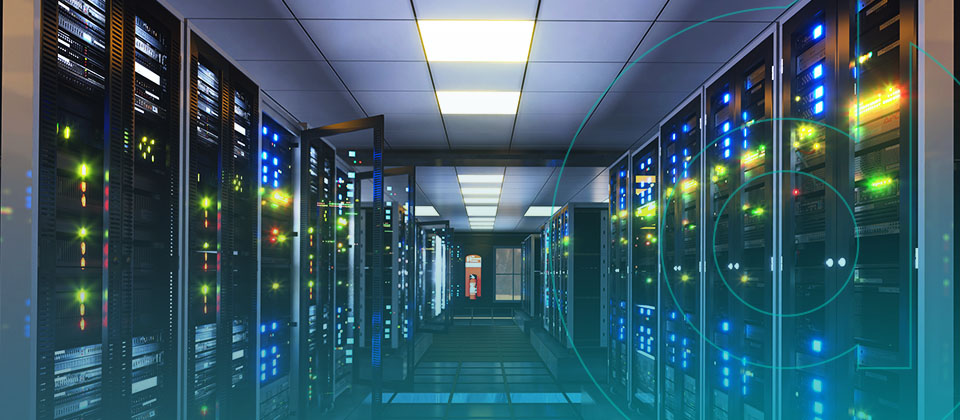5 Data Center Lighting Considerations
When most companies build or renovate their data centers, they’re focused on optimizing the space to secure as much data as possible. Lighting might not even cross their mind. However, the light fixtures you choose will significantly impact your data center’s efficiency.
Selecting the appropriate lighting will increase security, stabilize the temperature, minimize energy use and make it easier for your technicians to service the equipment. For a truly optimized data center, it’s essential to consider the most efficient lighting solutions.
5 Things to Consider When Choosing Data Center Lighting
When you’re building a data center, it’s tempting to use standard warehouse-style lighting because it’s simple and affordable. However, the light fixtures you choose will significantly impact the overall efficiency of your data center.
Selecting the appropriate lighting will increase security, stabilize temperature, minimize energy use and make routine maintenance easier for technicians. This guide explains how to choose the right lighting to protect and enhance your data center.
1. Visibility
Visibility is a crucial expectation for all data center lighting, as it can be challenging to see properly in a data center filled with rows of tall cabinets. Although small cables and input sockets can be difficult to see in dark spaces, installing bright bulbs will illuminate the space for more efficient work.
Emergency lighting and power supplies are also critical considerations that fall under data center lighting standards. Employees must be able to see and follow illuminated signs leading to emergency exits, according to the NFPA 101 standard. Adequate lighting is also essential for enabling computer engineers to identify and resolve potential emergencies before they escalate into serious situations.
2. Energy Efficiency
Data centers account for approximately 1% of the world’s energy consumption, and lighting is one of the best places to begin reducing costs in multiple areas.
Choosing a low-heat option is better for your equipment and conserves energy from cooling. A significant amount of energy is required to power a data center’s cooling and ventilation systems. LED lights can help maintain a stable temperature to reduce energy usage and cooling costs.
LED lighting is a cost-effective and environmentally conscious option due to its high energy efficiency. It produces minimal heat over extended usage periods, which is ideal for temperature-sensitive data centers.
3. Lighting Placement
Proper lighting placement is essential for optimal visibility. Light fixtures are typically installed in a grid pattern on the ceiling. Your lights must line up with the aisles between the rows of equipment to prevent the cabinets and racks from casting shadows where IT technicians work. Carefully plan the ceiling grid so that the lighting is directly above the open rows to maximize visibility in the room.
A traditional drop ceiling with large panel lights is challenging to arrange in coordination with rows of equipment. The standard sizing of each panel allows for only minimal customization. Narrow pendants with one or two tubes are more versatile for illuminating tight spaces. You can hang them directly above the aisles to penetrate the cabinet’s interior as much as possible.
4. Automated Controls
Because data centers are often unoccupied, the need to keep bright lights on is significantly reduced. Sensors will automatically power the lights on and off when staff members enter and exit the room to guarantee minimal energy usage. It’s essential to install sensors throughout the room, as cumbersome equipment can obstruct an employee’s view and prevent the sensor from picking up their presence.
Advanced lighting systems can also be set on a schedule, timed to turn on and off to match usage patterns. Powering off the lighting when it’s not in use could lead to significant energy savings.
5. Installation
While standard lay-in grids are easier to install than other lighting arrangements, they limit data center lighting visibility due to the challenges associated with lighting and aisle coordination.

For example, large equipment could end up blocking lighting panels unless they’re precisely aligned. Spacing cabinets out to accommodate lighting can decrease the center’s utility, so it’s best to focus on lining up lighting with each aisle in the design stage of the process.
A cluster of suspension rods and mountings can also be complicated and get tangled up with cables and other overhead equipment. Mounting a sturdy, suspended ceiling track provides the versatility to install your lighting, cable trays and other devices in the ideal location.
Data Center Lighting Standards
Since data centers are utilized differently throughout the day, adaptive lighting can adjust to these needs while conserving energy. A three-level lighting protocol is recommended:
Level 1
The first level of lighting is ideal when the data center is vacant. The space should be illuminated slightly to allow for optimal video surveillance to protect the facility. Infrared security cameras can operate in total darkness, allowing you to conserve your lighting entirely.
Level 2
The second level of lighting should be initiated when staff members enter the room. Internet-connected sensors are convenient for automatic lighting adjustment and monitoring. The lighting should be bright enough to enable employees to safely navigate between the rows of equipment and perform basic tasks. The additional lighting will also make it easier for security to identify who has entered the room.
Level 3
The third level of illumination is intended for equipment maintenance and repairs. It is the brightest level, allowing the technician to see the entire contents of the cabinet. This lighting should be placed in the aisles themselves, between the racks. Technicians could also utilize transportable lighting to illuminate specific zones.
Why LED Is the Best Data Center Lighting Choice
The ideal lighting for data centers is bright, adaptable, energy-efficient and dependable. LED lighting provides all these features for maximum function and value. LED bulbs use minimal energy to illuminate the space to your desired brightness.
They’re long-lasting, requiring fewer bulb replacements to reduce maintenance costs. LED light bulbs last 30 times longer than incandescent lighting and up to five times longer than compact fluorescent light (CFL) bulbs. They also emit far less heat, reducing cooling requirements and operating costs.
Data center LED lighting can help streamline operations so you only consume energy where and when it’s essential. New intelligent LED lighting systems dynamically adjust each room’s brightness based on occupancy and daylight availability, so your data center can reduce energy use without having to manually adjust lighting throughout each shift.
LED light fixtures also come in innovative designs that deliver functional advantages to spaces with challenging layouts, such as server rooms. With capacities for various lighting colors and a lack of UV emissions, you can easily illuminate your data center with lighting that’s safe for long-term use.

Optimize Your Data Center Lighting System With DataSpan
LED data center lighting is a simple but impactful method to optimize your facility. The experts at DataSpan can help you choose industry-leading light fixtures and improve every aspect of your data management techniques.
We work closely with you to deliver a wide range of custom solutions that address your data center’s specific needs. Our team has decades of experience designing and implementing data center solutions such as lighting, flooring, security and much more, and we use that knowledge to inform every project we take on.
Whether you’re building, renovating or simply working to enhance data center operations, DataSpan can help you create efficient power solutions and infrastructure with cutting-edge products and services. Contact us today to transform your facility into a secure and reliable data center.
Linked Sources:
https://dataspan.com/blog/data-center-cooling-costs/
https://dataspan.com/blog/data-center-power-energy-saving-tips/
https://dataspan.com/blog/lights-out-data-centers-explained/
https://dataspan.com/blog/cable-management-solutions/
https://energyinnovation.org/2020/03/17/how-much-energy-do-data-centers-really-use/
https://www.energy.gov/energysaver/led-lighting
https://dataspan.com/data-center/
https://dataspan.com/data-center/power-solutions/

About the Author: Alex von Hassler’s long term focus is the continued testing, learning, and deployment of modern IT solutions. During his years as a DataSpan team member, his responsibilities grew from managing Salesforce CRM to improving system security, creating marketing initiatives, as well as providing continued support to the highly motivated and experienced team in an ever-changing industry. As DataSpan evolves to provide the best-fitting IT solutions to its customers, Alex von Hassler continues to hone his skills in the world of web-based ERP systems, security, and best customer engagement practices. Empowering such a dynamic team with the right tools provides him with enormous gratification.








